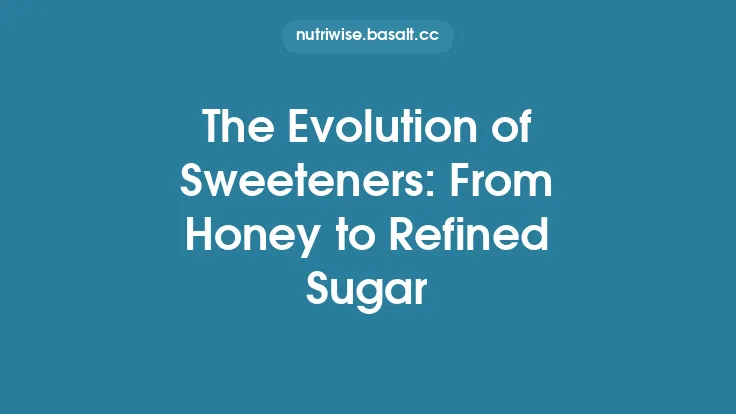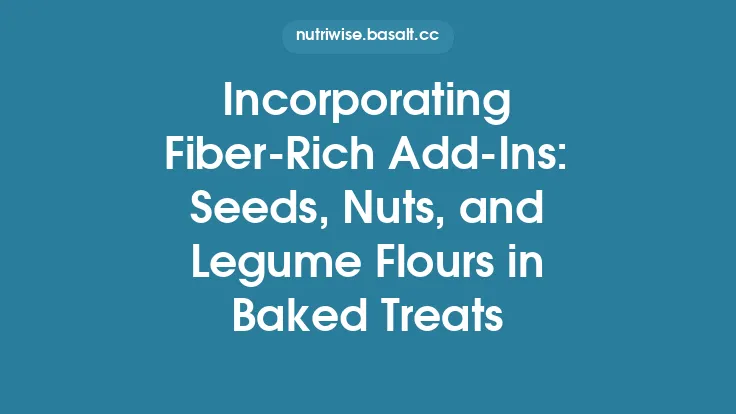Reducing sugar in baked goods is more than a simple swap; it’s a thoughtful re‑engineering of flavor, texture, and chemistry. While the allure of a sweet bite is universal, modern bakers increasingly seek ways to keep that pleasure while cutting down on refined sucrose. This article explores the science behind sugar in baking, profiles natural sweeteners that preserve flavor, and offers practical strategies for successful substitutions across a range of baked treats.
Understanding Sugar’s Multifunctional Role
Sugar is not merely a sweetener. In most baked goods it performs several critical functions:
| Function | How Sugar Contributes | What Happens When It’s Reduced |
|---|---|---|
| Sweetness | Binds to taste receptors, providing the primary flavor cue. | Perceived blandness; other flavors may become more pronounced. |
| Moisture Retention | Hygroscopic nature draws water into the batter/dough, keeping products moist. | Drier crumb, shorter shelf life. |
| Browning (Maillard & Caramelization) | Reacts with proteins and amino acids at high temperatures, creating golden crusts and complex flavors. | Lighter color, less depth of flavor. |
| Structure & Leavening | Sugar crystals aerate butter during creaming, trapping air that expands during baking. | Denser texture, reduced rise. |
| Tenderizing | Interferes with gluten formation, yielding a softer crumb. | Tougher, chewier texture. |
When reducing sugar, the goal is to replace or compensate for these roles without compromising the final product.
Natural Sweeteners: Profiles and Baking Behavior
| Sweetener | Source | Sweetness Relative to Sucrose | Key Functional Traits | Ideal Uses |
|---|---|---|---|---|
| Honey | Bee‑produced nectar | 1.2–1.5× | Adds moisture, promotes browning, subtle floral notes. | Quick breads, muffins, granola bars. |
| Maple Syrup | Sap of sugar maple | 1.3× | Distinct caramel‑like flavor, high water content, contributes to a tender crumb. | Oatmeal cookies, pancakes, spice cakes. |
| Coconut Sugar | Sap of coconut palm | 0.8× | Low glycemic index, mild caramel flavor, similar granule size to brown sugar. | Brownies, ginger snaps, spice cookies. |
| Date Sugar | Ground dried dates | 0.8× | Adds fiber, subtle fruity notes, does not dissolve fully (adds texture). | Crumbly bars, streusel toppings, rustic scones. |
| Monk Fruit Extract | Luo Han Guo fruit (often blended with erythritol) | 150–250× (concentrated) | Zero calories, no aftertaste when high‑purity, does not contribute moisture. | Light cakes, meringues, frostings (use in small amounts). |
| Stevia (Leaf Extract) | Stevia rebaudiana leaves (often blended) | 200–300× (concentrated) | Intense sweetness, possible bitter aftertaste at high levels, no bulk. | Frostings, glazes, low‑moisture cookies. |
| Brown Rice Syrup | Enzymatically broken down rice starch | 0.5× | Mildly nutty, high viscosity, adds chewiness. | Granola, chewy bars, some Asian pastries. |
| Yacon Syrup | Yacon root (fructooligosaccharides) | 0.5× | Prebiotic fiber, low glycemic impact, liquid. | Muffins, quick breads, low‑calorie desserts. |
| Erythritol | Sugar alcohol from fermented corn | 0.7× | Crystallizes like sugar, cooling mouthfeel, no calories. | Cookies, brownies, frostings (often blended with other sweeteners). |
| Xylitol | Sugar alcohol from birch wood or corn cobs | 1× | Similar bulk to sugar, hygroscopic, can cause digestive upset in excess. | Dense cakes, cookies, fruit pies. |
Key Takeaway: No single natural sweetener replicates all of sucrose’s functions. Successful reduction often involves blending two or more sweeteners to balance sweetness intensity, moisture contribution, and bulk.
Calculating Substitution Ratios
- Determine Desired Sweetness Reduction
- Example: Reduce sugar by 30 % in a chocolate chip cookie recipe that calls for 1 cup (200 g) granulated sugar.
- Select Sweetener(s) Based on Functional Needs
- For cookies, moisture and spread are crucial. A blend of honey (for moisture & browning) and erythritol (for bulk) works well.
- Apply Sweetness Equivalency
- Honey: 1 cup honey ≈ 1.25 cup sugar in sweetness.
- Erythritol: 1 cup erythritol ≈ 0.7 cup sugar in sweetness.
- Calculate Replacement
- Target sugar amount after reduction: 200 g × 0.70 = 140 g.
- Choose 70 g honey (≈ ½ cup) → sweetness ≈ 87.5 g sugar equivalent.
- Remaining sweetness needed: 140 g − 87.5 g = 52.5 g.
- Convert to erythritol: 52.5 g ÷ 0.7 ≈ 75 g erythritol.
- Adjust for Moisture
- Honey adds ~21 % water. Reduce other liquids (milk, oil) by ~1 Tbsp to maintain dough consistency.
Result: Replace 200 g sugar with 70 g honey + 75 g erythritol, and cut 1 Tbsp of liquid. The cookie retains sweetness, moisture, and spread while cutting refined sugar by 30 %.
Blending Sweeteners for Balanced Flavor and Texture
| Blend | Ratio (by weight) | Benefits |
|---|---|---|
| Honey + Erythritol | 1:1 | Moisture + bulk; reduces after‑taste of erythritol. |
| Maple Syrup + Coconut Sugar | 2:1 | Rich caramel notes, moderate sweetness, retains some granule texture. |
| Monk Fruit + Stevia (high‑purity) | 3:1 | Mitigates stevia’s bitterness, provides bulk when mixed with a bulking agent like powdered erythritol. |
| Date Sugar + Brown Rice Syrup | 1:1 | Adds fiber and chewiness, suitable for granola bars and crumbly toppings. |
| Xylitol + Coconut Sugar | 1:1 | Near‑sucrose sweetness, retains browning, good for dense cakes. |
When blending, always taste the mixture before adding to the batter. Adjust by adding a pinch of salt or a splash of vanilla extract to round off any lingering after‑taste.
Flavor Enhancers That Reduce the Need for Sweetness
- Spices & Aromatics
- Cinnamon, nutmeg, cardamom, ginger amplify perceived sweetness through olfactory cues.
- Vanilla extract (or vanilla bean paste) adds depth, making a product taste sweeter without extra sugar.
- Acidity Balancing
- A small amount of lemon zest or cream of tartar can brighten flavors, reducing the desire for added sugar.
- Umami Boosters
- A pinch of sea salt or miso paste (in chocolate or caramel desserts) creates a flavor contrast that enhances overall sweetness perception.
- Texture Contrast
- Adding a crunchy topping (toasted nuts, oat streusel) provides sensory satisfaction, allowing for lower overall sweetness.
Practical Substitution Guides for Common Baked Goods
1. Cookies
- Goal: Preserve spread and crisp edges.
- Strategy: Use a 50/50 blend of liquid sweetener (honey or maple syrup) and a granular low‑calorie sweetener (erythritol or xylitol). Reduce butter by 5 % to offset extra liquid. Add a teaspoon of cornstarch to maintain crispness.
2. Cakes
- Goal: Maintain tender crumb and moist interior.
- Strategy: Replace up to 40 % of sugar with pureed fruit‑based sweeteners (e.g., unsweetened pumpkin puree) only if the article’s scope permits—but since fruit purees are excluded, opt for coconut sugar combined with monk fruit extract. Increase liquid (milk or yogurt) by 2 Tbsp for each ¼ cup of liquid sweetener used.
3. Muffins & Quick Breads
- Goal: Achieve a moist, airy texture.
- Strategy: Substitute 30 % of sugar with yacon syrup (adds prebiotic fiber) and the remainder with erythritol. Add an extra ¼ tsp of baking powder to compensate for reduced sugar’s leavening assistance.
4. Brownies & Bars
- Goal: Preserve fudgy chew and glossy crust.
- Strategy: Use date sugar for bulk and a small amount of maple syrup for moisture and caramel notes. Reduce baking time by 2–3 minutes to prevent over‑drying due to lower sugar caramelization.
5. Pie Fillings & Tarts
- Goal: Achieve proper set and glossy finish.
- Strategy: Combine coconut sugar with stevia (high‑purity) to keep the filling thick while cutting sugar by half. Add a thin slurry of cornstarch (1 Tbsp) to ensure proper thickening.
Storage, Shelf Life, and Safety Considerations
- Moisture‑Rich Sweeteners (Honey, Maple Syrup): Increase water activity, potentially shortening shelf life. Store baked goods in airtight containers and refrigerate if humidity is high.
- Sugar Alcohols (Erythritol, Xylitol): Can crystallize over time, leading to a grainy texture. Re‑heat gently or add a small amount of glycerin to retain softness.
- Stevia & Monk Fruit Extracts: Highly stable; however, they can cause a slight after‑taste that intensifies with prolonged storage. Pair with vanilla or a pinch of salt to mask.
- Allergenic Potential: Some natural sweeteners (e.g., honey) are not suitable for vegans or for infants under one year. Clearly label products when serving to diverse audiences.
Health Implications of Natural Sweeteners
| Sweetener | Caloric Impact | Glycemic Index (GI) | Notable Nutrients | Potential Drawbacks |
|---|---|---|---|---|
| Honey | 64 kcal/Tbsp | 45–55 | Small amounts of antioxidants, trace enzymes | Higher GI than some alternatives; not vegan |
| Maple Syrup | 52 kcal/Tbsp | 54 | Manganese, zinc | Strong flavor may dominate delicate desserts |
| Coconut Sugar | 15 kcal/Tsp | 35 | Iron, zinc, potassium | Still contains fructose; moderate calorie content |
| Date Sugar | 15 kcal/Tsp | 30 | Fiber, potassium, magnesium | Does not dissolve fully; can add gritty texture |
| Monk Fruit Extract | 0 kcal | 0 | None (pure extract) | May contain erythritol filler, which can cause digestive upset in large amounts |
| Stevia | 0 kcal | 0 | None (pure extract) | Bitter aftertaste at high concentrations |
| Erythritol | 0.2 kcal/g | 0 | None | Cooling mouthfeel; large doses may cause mild GI discomfort |
| Xylitol | 2.4 kcal/g | 7 | None | Toxic to dogs; can cause digestive upset in humans if over‑consumed |
Bottom line: While natural sweeteners can dramatically lower added sugar and caloric load, they are not universally “free‑of‑consequences.” Choose based on the target audience’s dietary restrictions, the desired flavor profile, and the functional role sugar plays in the specific baked good.
Troubleshooting Common Issues
| Symptom | Likely Cause | Fix |
|---|---|---|
| Dry, crumbly texture | Too much bulk sweetener (e.g., erythritol) without enough moisture. | Increase liquid (milk, oil) by 1–2 Tbsp or add a tablespoon of applesauce (if fruit purees are permissible) or yogurt. |
| Excessive spreading (cookies) | High proportion of liquid sweetener (honey, syrup). | Chill dough 30 min before baking; add 1 Tbsp extra flour. |
| Pale crust | Insufficient caramelization due to low‑calorie sweetener. | Brush top with a thin layer of honey or maple syrup before baking; increase oven temperature by 10–15 °F for the last 5 minutes. |
| Grainy mouthfeel | Undissolved granulated sweetener (date sugar, coconut sugar). | Pulse sweetener in a food processor or blend with a small amount of flour before incorporation. |
| Bitter aftertaste | Overuse of stevia or monk fruit. | Dilute with a neutral bulk sweetener (erythritol) and add a pinch of salt or vanilla. |
| Chewy, gummy interior (brownies) | Too much hygroscopic sweetener (honey, brown rice syrup). | Reduce total sweetener by 10 % and increase leavening (baking soda) slightly. |
Final Thoughts
Reducing refined sugar in baked goods does not have to mean sacrificing taste or texture. By understanding sugar’s multifaceted role, selecting natural sweeteners that complement those functions, and employing strategic blends and flavor enhancers, bakers can craft desserts that are both health‑conscious and indulgent. The key is experimentation—start with modest reductions, keep detailed notes on ratios and outcomes, and adjust based on the specific product you’re perfecting. With these tools, every kitchen can produce sweet treats that delight the palate while supporting a healthier lifestyle.





